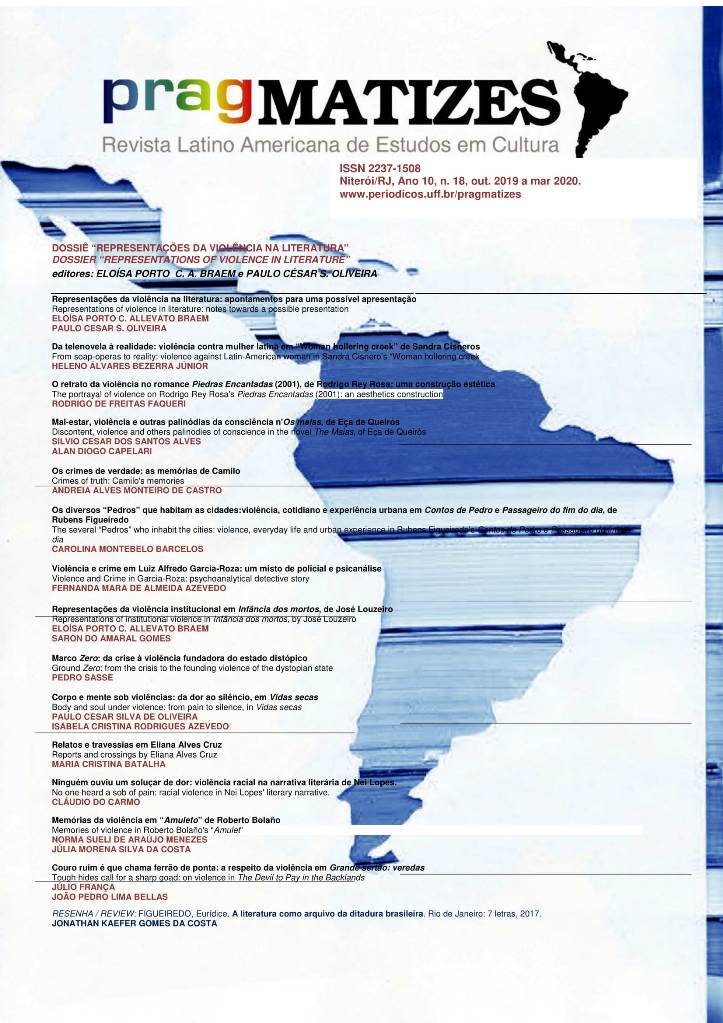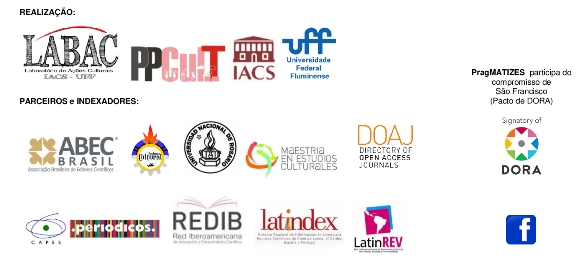From soap-operas to reality: violence against Latin-American woman in Sandra Cisnero’s “Woman hollering creek
DOI:
https://doi.org/10.22409/pragmatizes.v10i18.40246Keywords:
Feminicide, Latin America, Misplaced identities, Cultural resistance, Post-ColonialismAbstract
: In order to illustrate and prompt a discussion on feminicide in Latin America (highlighting Mexico and Brazil), this article makes use of hideous events experienced by the protagonist of “Woman hollering creek”’: a Latin American woman, ignorant of English language and victim of domestic violence in a Texan Chicana Community, who is literally compared to the mythic La Llorona. Being so, the text highlights the role of Latin-American soap-operas of disseminating and perpetuating concepts like “idealized love” and prosperity in the USA (American Dream) for the sake of a heteronormative family paradigm. Devoted to the ideal of perfect happy family, the Latin woman is confined to domesticity, being secluded from intellectual enterprises and from participating in the marketplace. By intensifying the feminist perspective on the Latin woman’s idiosyncrasies, topics peculiar to the Post-colonial Theory, and Post-colonial Feminism like misplaced and marginal identities, cultural resistance, interculturality, linguistic and cultural untranslatability as well as the diasporic practice for the sake of a better life will be stressed. Likewise, given that uneventful representations of blurred borders between Englishness and Hispanicity are also at stake in the short-story, this analysis will show how strongly readings about the Fantastic, Magic Realism and Post-colonial Gothicism point to a multicultural portrayal of the Latin-American hollering woman, an icon of resistance, subservience and suffering thanks to Latin American patriarchal structures.
Downloads
References
ALMEIDA, Heloísa B.. Consumidoras e heroínas: gênero na telenovela. Revista estudos feministas. v. 15 n. 1 p. 177-192 2007.
ASHCROFT, Bill et alii. Magic Realism. In: ___. Post-Colonial Studies: The
Key Concepts. London: Routledge, 1998. p. 132-3
AUSTEN, Jane. Pride and prejudice. London and New York: Penguin, 1994.
AZZAM, Julie Hakim. The alien within: postcolonial gothic and the politics of home. (Doctoral Dissertation). Pittsburgh: University of Pittsburgh, 2007. https://core.ac.uk/download/pdf/12209344.pdf Access on December 19th, 2019.
BHABHA, Homi. O local da cultura. Trad. Maria Ávila et alii. Belo Horizonte: UFRMG, 2010.
______. Narrating the nation. In: BHABHA, Homi (ed.). Nation and narration. London: Routledge, 1995. p.1-7
BASSNETT, Susan. Questões centrais. Trad. Sônia Terezinha Gehring et alii. Estudos de tradução. Porto Alegre: UFRGS, 2005. p. 35-62
BONNICI, T. Introdução ao estudo das literaturas pós-coloniais. Mimesis, Bauru, v. 19, n. 1, p. 07-23,1998.
BRASIL. Lei nº 11.340. Brasília. Código penal, 2006.
CALAZANS, Janaina de H. C.. O cotidiano fabuloso: os temas recorrentes e o uso de arquétipos dos contos de fada nas telenovelas brasileiras. (Mestrado em Comunicação). Recife: Universidade Federal de Pernambuco, 2003.
CÁLIZ-MONTORO, Carmen. Defying otherness: Chicano geopolitical, literary and historical imprints. In: ___. Writing from the borderlands: a study of Chicano, Afro-Caribbean and Native Literatures in North America. Toronto: Tsar, 2000. p. 3-17 ^
CAMPEDELLI, Samira Y. A telenovela. São Paulo: Ática, 1985.
CISNEROS, Sandra. “El arroyo de la Llorona”. In: ___. El arroyo de la llorona y outros cuentos. Trad. Liliana Valenzuela. Neuva York: Vintage Español, 1996. p. 47-61
______. Woman Hollering Creek. In: ---. Woman hollering creek and other stories. New York: Vintage Books, 1992. p. 43-56
DERRIDA, Jacques. A escritura e a diferença. São Paulo: Perspectiva, 1995.
FOUCAULT, M. Vigiar e punir: história da violência nas prisões. Petrópolis: Vozes, 1987.
Gazeta digital. Dados do Itamaraty: imigração ilegal causa mais de 50% das prisões de brasileiros nos EUA. Cuiabá, 19 de dezembro, 2019. https://www.gazetadigital.com.br/editorias/mundo/imigrao-ilegal-causa-mais-de-50-das-prises-de-brasileiros-nos-eua/580779 Acesso em 20/12/2019.
GHERARDI, Nathalia. Violência contra as mulheres na América Latina. Trad. Akemi Kamimura. Buenos Aires: Sur. v. 23 n. 24 2017 p. 129-136. http://sur.conectas.org/wp-content/uploads/2017/02/12-sur-24-por-natalia-gherardi.pdf Acesso em 14/12/2019
G1 – Jornal online. A guerra contra as mulheres no México. Rio de Janeiro, 20/08/2019. https://g1.globo.com/mundo/noticia/2019/08/20/a-guerra-contra-as-mulheres-no-mexico.ghtml Acesso em 03/11/2019
______. Casos de feminicídio aumentam 76% no 1º trimestre de 2019 em SP; número de mulheres vítimas de homicídio cai. Rio de Janeiro, 19/12/2019. https://g1.globo.com/sp/sao-paulo/noticia/2019/04/29/casos-de-feminicidio-aumentam-76percent-no-1o-trimestre-de-2019-em-sp-numero-de-mulheres-vitimas-de-homicidio-cai.ghtml Acesso em 19/12/2019.
HOOKS, Bell. Sisterhood: political solidarity between women. In: McCLINTON, A. et alii (eds.). Dangerous liasions: gender, nation and post-colonial perspectives. Minneapolis: University of Minnesota Press, 1997. p. 396-441.
LOPEZ, Mark Hugo et alii. Latinos are more likely to believe in the American dream, but most say it is hard to achieve. Fact Tank: news in the numbers. Washington: Pew Researcher Center, September 11th, 2018. p. 1 https://www.pewresearch.org/fact-tank/2018/09/11/latinos-are-more-likely-to-believe-in-the-american-dream-but-most-say-it-is-hard-to-achieve/ Access on December 19th, 2019.
MARQUES, Francisco C. A.. e RIBERIO, Rondinele A.. A telenovela no Brasil: um gênero por excelência. Cadernos Zygmunt Bauman. v. 6 n.11 p.78-92 2016.
MÉXICO, Estados Unidos de. Congreso General. Cámara de Diputados del H. Congreso de La Unión. Ley general de acesso de las mujeres a una vida libre de violência. Ciudade de México, 2007. Última reforma publicada DOF 13-04-2018
MINH-HA, Trinh T. Not you/like you: postcolonial women and the interlocking questions of identity and difference. In: ____ McCLINTON, A. et alii (eds.). Dangerous liasions: gender, nation and post-colonial perspectives. Minneapolis: University of Minnesota Press, 1997. p. 415-419
PÉREZ-TORRES, Rafael. The Mestizo Voice. In: ___. Critical Uses of Race in Chicano Culture. Minneapolis: University of Minnesota Press, 2006. 51-82
RUSHDIE, Salmon. Imaginary homelands: essays and criticism 1981 1991. London & New York: Granta Books, 1992.
SIMON, Sherry. Revising the boundaries of culture and translation. In: ___. Gender in translation: cultural identity and the politics of transmission. London & New York: Routledge, 1996. p. 134-167
SOUZA, Suellen A. de. Leis de combate a violência contra a mulher na América Latina: uma breve abordagem histórica. In: XXVII Simpósio Nacional de História. Anais de Conhecimento Histórico e Análise Social. Natal: ANPUH, 2011. p. 2-18
SPIVAK, Gayatri. Can the subaltern speak? In: NELSON C. & GROSSBERG, L. (eds.). Basingstoke: Macmillan Education, 1988. p. 271-313.
TODOROV, Tzvetan. Introdução à literatura fantástica. Tradução de Maria Clara Correa Castello. São Paulo: Perspectiva, 1975.
VARGENS, Renato. Maridos evangélicos que batem em suas esposas, 2017. http://renatovargens.blogspot.com/2012/01/maridos-evangelicos-que-batem-em-suas.html Acesso em 27/12/2019
Downloads
Published
How to Cite
Issue
Section
License
By forwarding an original to PragMATIZES, the authors agree that the copyright related to it is transferred to the Publishing. Articles and other writings are made available in PDF format from their publication, and they can be downloaded to institutional repositories and personal pages, provided that with their proper bibliographic indication.



